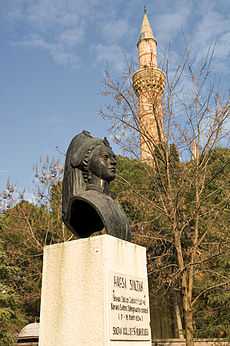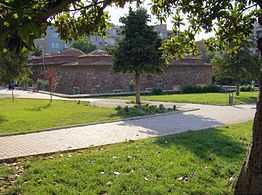Ayşe Hafsa Sultan
| Ayşe Hafsa Sultan | |||||
|---|---|---|---|---|---|
| Valide sultan | |||||
 Bust in Manisa | |||||
| Spouse | Sultan Selim I | ||||
| Issue |
Sultan Suleiman I Hatice Sultan Fatma Sultan Hafsa Sultan | ||||
| |||||
| House |
House of Giray (by birth) House of Osman (by marriage) | ||||
| Father | Meñli I Giray or Abd'ûl-Muin[1] | ||||
| Born |
5 December 1479 Bakhchisaray, Crimean Khanate | ||||
| Died |
19 March 1534 (aged 54) Constantinople, Ottoman Empire | ||||
| Burial | Yavuz Selim Mosque, Fatih, Constantinople[2][3] (present day Istanbul) | ||||
| Religion | Islam | ||||
Ayşe Hafsa Sultan[4] (fully Devletlu İsmetlu Ayşe Hafsa Valide Sultan Aliyyetü'ş-Şân Hazretleri; Ottoman Turkish: عائشہ حفصہ سلطان; 5 December 1479 – 19 March 1534), or in short, Hafsa Sultan, was the first "Valide Sultan" of the Ottoman Empire, wife of Selim I and mother of Suleiman the Magnificent. During the period between her son's enthronement in 1520 and her death in 1534, she was one of the most influential persons in the Empire, as her son's de facto co-regent during these fourteen years, coming second only to the sovereign, which is a point remarked also by the ambassadors of European powers at the Ottoman court.[5]
Origins
Although Ayşe Hafsa Sultan’s year of birth is known, historians debate that she was the daughter of Meñli I Giray.[6][7][8][9][10][11][12][13][14][15]
According to an alternative theory, the daughter of Meñli I Giray of the Crimean Khanate was the First consort of Selim I known as Ayşe Hatun, consequently the step-mother of Suleiman the Magnificent. However, Ayşe Hafsa Sultan is only confused with her and Ayesha Begum was the sister of Ayşe Hafsa Sultan and the wife of Sultan Selim I's brother Şehzade Mehmed. In 1511, she entered the harem Sultan Selim I, when he was the governor of Amasya, thus securing for him, in the person of her powerful father, a valuable ally in the prince's struggle for the throne.[16][17][18]
Life
Having resided in the city of Manisa in western Turkey with her son, who administered the surrounding region between 1513 to 1520, the town being one of the traditional residences for Ottoman crown princes (şehzade) in apprenticeship for future power, Ayşe Hafsa Sultan is the initiator of the Manisa's "Mesir Festival", a local tradition still continued today. She also had a large complex consisting of a mosque, a primary school, a college and a hospice built in the city.
She was also the first imperial spouse to be called by the title usually rendered in English language as "Sultana" (full title in Turkish; "Valide Sultan", literally "the Queen Mother" but in only approximate terms in the Ottoman context). Her period signalled the shifting status of the sultan's mother and her increased share in power.[19] After the birth of her son Suleiman, born 6 November 1494 in Trabzon, she had three daughters: Hatice, Fatma and Hafsa.
Burial place
Ayşe Hafsa Sultan died in March 1534 and was buried near her husband in a mausoleum behind the qiblah wall of Yavuz Selim Mosque, in Fatih, Istanbul. The mausoleum was largely destroyed in an earthquake in 1884, a reconstruction effort started in the 1900s (decade) having been left discontinued, and her tomb today is much simpler than it was built originally.
References
| Wikimedia Commons has media related to Ayşe Hafsa Sultan. |
- ↑ The Imperial House of Osman - 4
- ↑ The Encyclopædia Britannica, Vol.7, Edited by Hugh Chisholm, (1911), 3; Constantinople, the capital of the Turkish Empire...
- ↑ Britannica, Istanbul:When the Republic of Turkey was founded in 1923, the capital was moved to Ankara, and Constantinople was officially renamed Istanbul in 1930.
- ↑ There were half a dozen notable female figures in Ottoman history who were named "Hafsa". Among these, it is Ayşe Hafsa Sultan who is referred to as "Hafsa Sultan" in short, "Sultan" in this case standing for "Sultana".
A namesake also of primary historical prominence and who had preceded Ayşe Hafsa Sultan by about two centuries was the wife of the sultan Bayezid I and the daughter of İsa Bey, the last bey of Aydin, and she is generally referred to as Hafsa (Hâfize) Khātun. It is this earlier Hafsa who is at the origin of the final form the name of a town depending Edirne, Havsa, has taken.
The word Hâfiz designates a male person who memorized the Qur'an, and Hâfize indicates that the person is female. Hafsa is the more common and easier to pronounce, especially when fastly discoursed, of this name.
- ↑ Pietro Bragadin, Venetian Republic's ambassador in the early years of Suleiman the Magnificent's reign notes "a very beautiful woman of 48, for whom the sultan bears great reverence and love..." Leslie Peirce (1993). The Imperial Harem : Women and Sovereignty in the Ottoman Empire p. 62 ISBN 0-19-508677-5. Oxford University Press.
- ↑ Wander Stories (30 Dec 2013). Istanbul Tour Guide Top 10: a travel guide and tour as with the best local guide. WanderStories. ISBN 978-9-949-51624-7.
Hafsa Sultan was most likely the daughter of Mengli Giray
- ↑ Reşat Kasaba (1 Dec 2009). A moveable empire: Ottoman nomads, migrants, and refugees. University of Washington Press. p. 44. ISBN 978-0-295-80149-0.
Hafsa Sultan, the daughter of the Crimean ruler Mengli Giray Khan.
- ↑ Peter G. Bietenholz, Thomas Brian Deutscher (2003). Contemporaries of Erasmus: A Biographical Register of the Renaissance and Reformation, Volumes 1-3. University of Toronto Press. p. 298. ISBN 978-0-802-08577-1.
Suleiman i (Solymannus), known in the West as Suleiman the Magnificent, was the son of *Selim i and Hafsa Sultan, the daughter of Mengli Giray
- ↑ Brian Glyn Williams (1 Jan 2001). The Crimean Tatars: The Diaspora Experience and the Forging of a Nation. BRILL. p. 56. ISBN 978-9-004-12122-5.
Selim I (who married Mengli Giray Khan's daughter, Hafsa Hatum)
- ↑ Janusz Duzinkiewicz (2004). Derzhavi, Suspilʹstva, Kulʹtury: Skhid i Zakhid : Zbirnik Na Poshanu I︠A︡roslava Pelensʹkogo. Ross Pub. ISBN 978-0-883-54181-4.
- ↑ Halil İnalcık, Cemal Kafadar (1993). Süleymân The Second [i.e. the First] and his time. Isis Press.
she was a Tatar, a daughter of the Crimean Khan Mengli Giray
- ↑ André Clot, Matthew Reisz (2005). Suleiman the Magnificent. Saqi. p. 26. ISBN 978-0-863-56510-6.
His mother, Hafsa Hatun, is believed to have been the daughter of Mengli Giray, the khan of the Crimean Tartars.
- ↑ John Freely (1 Jul 2001). Inside the Seraglio: private lives of the sultans in Istanbul. Penguin.
Suleyman's mother, Hafsa Hatun, who was seventeen at the time of his birth, may have been a daughter of Mengli Giray, khan of the Crimean Tartars.
- ↑ Carolus Bovillus (2002). Lettres et poèmes de Charles de Bovelles: édition critique, introduction et commentaire du ms. 1134 de la Bibliothèque de l'Université de Paris. Champion. ISBN 978-2-745-30658-6.
- ↑ Henk Boom (2010). De Grote Turk: in het voetspoor van Süleyman de Prachtlievende (1494-1566). Athenaeum-Polak & Van Gennep. ISBN 978-9-025-36764-0.
- ↑ Family tree of Giray dynasty
- ↑ Gillian Long, Uradyn Erden Bulag, Michael Gervers (2005). History and society in central and inner Asia: papers presented at the Central and Inner Asia Seminar, University of Toronto, 16-17 April 2004. Asian Institute, University of Toronto. ISBN 978-0-772-77601-3.
- ↑ Elena Vladimirovna Boĭkova, R. B. Rybakov, Kinship in the Altaic World: Proceedings of the 48th Permanent International Altaistic Conference, Moscow 10–15 July 2005, pg.341
- ↑ Amy Singer (2002). Constructing Ottoman beneficence: An imperial soup kitchen in Jerusalem p. 90 ISBN 0-7914-5351-0. State University of New York Press.
Further reading
- Peirce, Leslie P., The Imperial Harem: Women and Sovereignty in the Ottoman Empire, Oxford University Press, 1993, ISBN 0-19-508677-5 (paperback).
- Yavuz Bahadıroğlu, Resimli Osmanlı Tarihi, Nesil Yayınları (Ottoman History with Illustrations, Nesil Publications), 15th Ed., 2009, ISBN 978-975-269-299-2 (Hardcover).
External links
- Plan: "Hafsa Sultan Complex". Archnet.
| Royal titles | ||
|---|---|---|
| Preceded by Emine Gülbahar Hatun |
Valide Sultan 30 September 1520 – 19 March 1534 |
Succeeded by Nurbanu Sultan |
